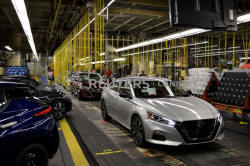U.S. auto sales stay on recovery path despite tight
inventory
 Send a link to a friend
Send a link to a friend
 [October 02, 2020] By
Rachit Vats [October 02, 2020] By
Rachit Vats
(Reuters) - The U.S. auto sector on
Thursday continued to show signs of a recovery from the COVID-19
pandemic as improving demand in the third quarter for new vehicles has
General Motors Co <GM.N> and other major automakers scrambling to boost
production to rebuild dealer inventories.
While sales in the quarter were down, the trend was positive as demand
increased each month, especially among retail consumers for high-profit
sports utility vehicles and pickup trucks, industry officials said.
"While the economy has made a substantial rebound in the third quarter,
retail auto sales have been even more resilient," GM Chief Economist
Elaine Buckberg said. "Super-low auto loan interest rates have boosted
retail auto sales; yet more strength comes from pandemic-induced
demand."
The third quarter is usually when the industry starts building new
models, and piling up inventory for the holiday season. That transition
is way behind the normal schedule this year due to the earlier shutdown
caused by the outbreak and the initial slow ramp-up in production.

Industry inventories for full-size pickup trucks, for example, stood at
500,000 vehicles heading into Labor Day this year, down from 900,000
last year, according to J.D. Power analyst Tyson Jominy.
GM, which reported a 10% decline in third-quarter sales but said results
improved each month, said the seasonally adjusted sales pace for the
quarter was expected to be 15.9 million vehicles, up about 4 million
vehicles from the previous quarter.
The U.S. auto sector has held up better than other industries, but
automakers had a hand in that with aggressive incentives like
zero-for-84 months financing, payment deferrals and job assurance
programs, J.D. Power's Jominy said.
Automaker profits are also getting a boost.
[to top of second column] |

A finished Nissan Maxima
followed by a Nissan Altima comes off the line at Nissan Motor Co's
automobile manufacturing plant in Smyrna, Tennessee, U.S., August
23, 2018. REUTERS/William DeShazer/File Photo

Vehicle prices rose 2.5% in September from last year to an average of more than
$38,700, Kelley Blue Book said. And incentive spending in the industry fell for
the second straight month in September, the first time that has happened since
April 2019, Jominy said.
"Automakers are going to report some pretty monster financial quarters here to
close a year," he said. "They're running the assembly plants flat-out right now
and incentives are falling. There's a lot of positive financial indicators right
now in the market." Toyota Motor Corp's <7203.T> U.S. sales fell 11% in the
third quarter, but were up 16% in September.
Fiat Chrysler Automobiles NV <FCAU.N><FCHA.MI> reported a 10% fall in U.S. sales
in the quarter, but they were 38% higher than the prior quarter and the company
cited strong consumer demand.
“We are optimistic about the U.S. market and expect sales to remain strong as we
close out 2020,” FCA's U.S. sales chief, Jeff Kommor, said.
Nissan Motor Co <7201.T> echoed the theme of improving retail sales despite a
32% decline in the quarter.
"From an industry perspective, consumer confidence in the market is rising,"
said David Kershaw, Nissan's North American sales chief.

(Reporting by Rachit Vats in Bengaluru; Additional reporting by Ben Klayman in
Detroit; Editing by Maju Samuel and Matthew Lewis)
[© 2020 Thomson Reuters. All rights
reserved.] Copyright 2020 Reuters. All rights reserved. This material may not be published,
broadcast, rewritten or redistributed.
Thompson Reuters is solely responsible for this content. |